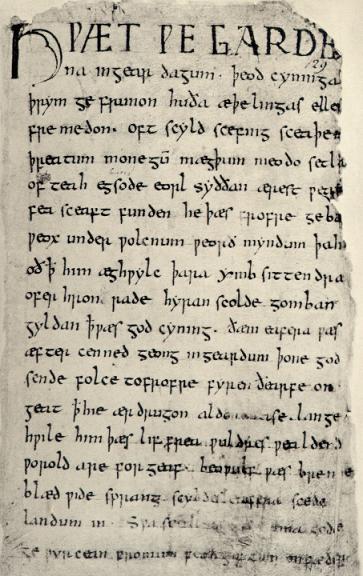
Anno .
Learning a language that has many similarities to English and yet appears so foreign can be a huge obstacle to successfully completing the learning process. Sounds that are not in your language, familiar sounds that have different letters, countless tables of endings for nouns and verbs and vowels that change can be rather difficult to pin down.
This supplementary guide to the basic language program is designed to provide an historical basis for the English language in conjunction with your studies of German. As you read through this guide you find many similarities between the two languages. While many of these characteristics in English disappeared through the centuries, they have been maintained to a large extent in German. The guide will show those characteristics that are common to both Modern High German and the stages of English. Most of the focus will be on Old English, as you will find the most common characteristics regarding the verb, but examples from later in the history of the English language will also show these similarities. For instance, a man named Shakespeare will make an appearance or two.
In each section you will find first the information designed to draw parallels between English and German; extensive tables of examples will be provided and will be followed in most sections by a series of practice exercises and activities, which are located on the Quia online platform.
What is the Old English Language?
As early as 450 several Germanic tribes from present-day Denmark migrated to the British Isles and settled there and established a variant of the language that was spoken in their source regions. Old Saxon was spoken in the source region, whereas the variant spoken on the island came to be known as Englisc (English). The peoples there suffered many invasions from other peoples, first from Celtic peoples around 600, then from the Vikings beginning around 800 and eventually in 1066 from the Normans, who brought the French language to the island. The Old English period therefore can be dated from roughly 450 to 1150 (Henriksen and van der Auwera 16).
Those of you who read Beowulf in a high school literature class will know that the language in which the epic was written is called Old English, which after a superficial glance does not seem to look like English at all as it has many endings and strange-looking letters. Even though the words themselves may have survived into today's English (sometimes in the same form that they had one-thousand years ago), the endings on the nouns, adjectives, and verbs for the most part have not survived. Old English had a rich inflectional system (many endings on nouns, verbs, etc.), some of which you will find in Modern German. Modern English lacks these endings, as most of these endings disappeared during the Middle English period (c. 1150 - c. 1550) (Henriksen and van der Auwera 17), although some verb endings are still found in Shakespeare (c. 1600).
The Old English Alphabet
Most of the consonants in Old English represent the same sounds as in Modern English, but the majority of the letters for vowels (and some letters for consonants) signify different sounds from their Modern English counterparts. There are also a few letters that have not survived into Modern English and give Old English its very foreign appearance. Below is a table of those letters that signified different sounds in Old English.
Vowels
All vowels were either long or short. Modern transcriptions indicate a long vowel with a macron (line) over the vowel.
| Letter | Sound | Nearest English Equivalent |
|---|---|---|
| a | "ah" | father |
| æ (ash) | "æ" | cat |
| e | "eh" | short: bet long: "Canada, eh" |
| i | "i", "ee" | short: bit long: beet |
| o | "oh" | go (without the glide into "u") |
| u | "oo" | boot |
| y | "i", "ee" | same as "i"1 |
1In some dialects of Old English, <y> was pronounced much like German <ü>. Elsewhere, the letter <y> was often used interchangeably with <i>, especially in later manuscripts.
Consonants
| Letter | Pronunciation |
|---|---|
| c | "k" before <a>, <o> and <u> "ch" before <æ>, <e> and <i> |
| f | "f" "v" between vowels |
| g | hard "g" before <a>, <o> and <u> "y" before <æ>, <e> and <i>, as in "yell" |
| h | "h" German "ch" before <t> |
| ſ (long "s") | "s" |
| ſc | "sh" |
| cg | "j", as in "edge" |
| þ (thorn) ð (eth) |
"th" (both hard and soft), used interchangeably |
| ƿ (wynn) | "w" (replaced by "w" in modern transcriptions) |
So how did Old English sound and look?
You might be wondering just how the language looked when written down. Below is the first page of Beowulf from the damaged Nowell manuscript. Some of the letters look much like they look when printed today. Because of those few letters which do not appear in today's alphabet, this guide provides a transription and a word-for-word translation of the first few lines of the nearly 3200-line poem.

| Old English (transcription) | Modern English (word-for-word) |
|---|---|
|
HWÆT! WĒ GĀR-DEna in geārdagum þēodcyninga þrym gefrūnon, hū ðā æþelingas ellen fremedon. Oft Scyld Scēfing sceaþena þrēatum manegum mǣgþum meodosetla oftēah, egsode eorlas syððan ǣrest wearð fēasceaft funden. |
LO! WE GAR-DANES in days of yore of the kings' glory heard, how the princes courage performed. Often Scyld from the hosts of warriors, from many clans mead-seats took, threatened noblemen when first was (he) destitute found. |
Finally, so you can get a feel for the sounds of the language, here is a recording of these first few lines of Beowulf, performed by Christopher Ruwe.
Next: Sounds and Cognates
![]()